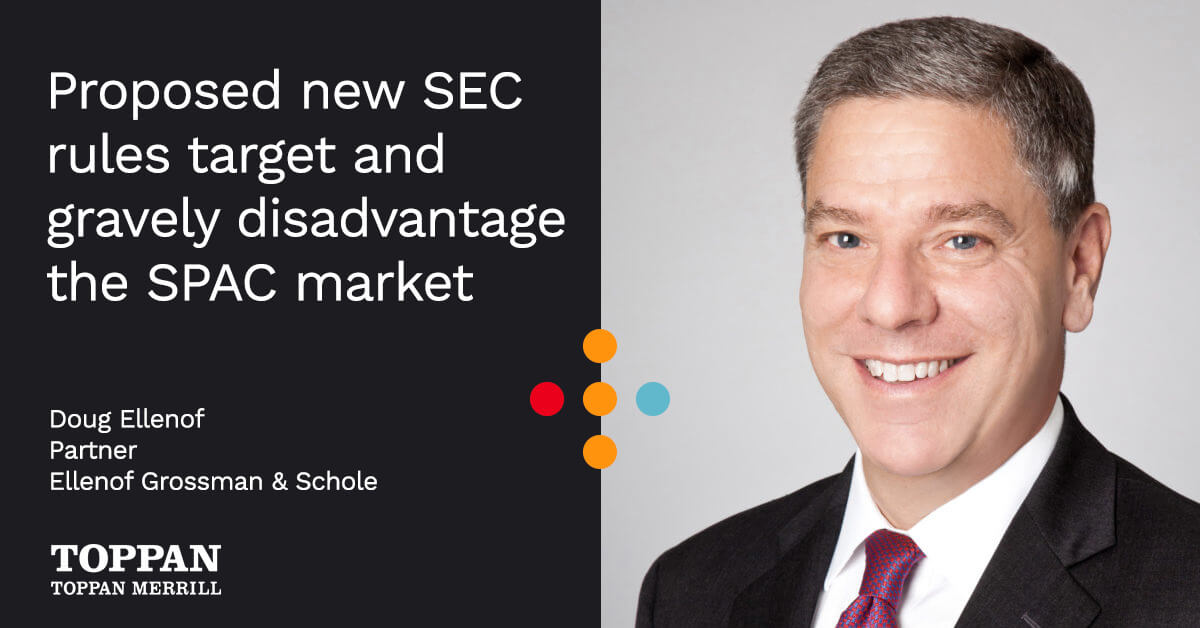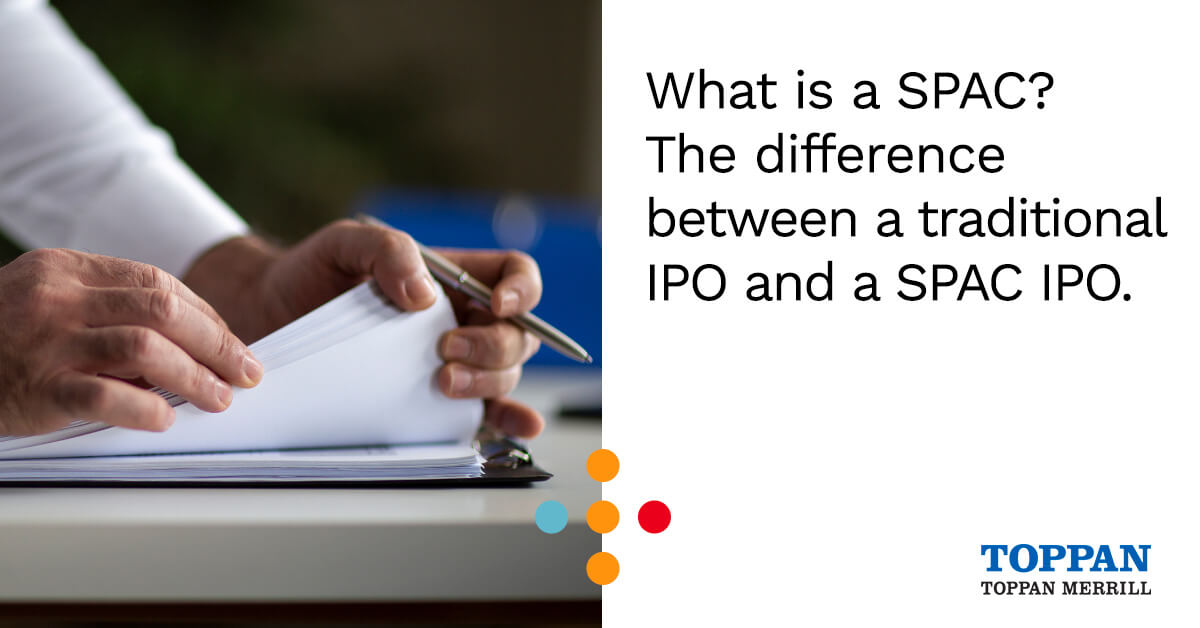In 2020, a new acronym burst into the mainstream business lexicon: SPACs, or special purpose acquisition companies.
In the simplest sense, SPACs offer a faster, cheaper way of taking a company public. By sidestepping the expensive underwriting fees, arduous road shows, and unpredictable market pricing associated with initial public offerings (IPOs), SPACs have emerged as an attractive alternative strategy for investors and business owners alike.
If you’re thinking about any kind of financing options or an exit of some sort, you need to know how they work.”
Because they are essentially shell companies, SPACs go public quickly – at a set price – then usually have 24 months to merge with a target company. If all goes well, the target company goes public at a negotiated M&A-based valuation without being subjected to the more costly and time-consuming process of a traditional IPO; SPAC sponsors are well compensated for facilitating the transaction and offering operational and financing expertise to the target; and retail investors get to participate in a buyout.
SPACs – more than 300 of which were issued in 2020, up from 59 in 2019 – have become a bona fide third way, somewhere between an IPO and an M&A exit. In addition, SPACs can be an opportunity to raise capital and create liquidity for sellers – both of which contribute to what has been called the hottest asset class in American equity markets.
Business leaders of all kinds are taking note. And those who haven’t, should, says Josh DuClos, a Sidley partner based in Los Angeles. “Even if SPACs aren’t relevant to you right now, if you’re thinking about any kind of financing options or an exit of some sort, you need to know how they work,” he says. “In the same way you need to know how IPOs and buyouts work.”
DuClos observes that between a robust new pipeline of SPAC acquirers and corporate America’s growing familiarity with SPAC transactions, the next two years will likely see a significant amount of SPAC deal-making, resulting in knock-on impacts to both the M&A and IPO markets, and creating a new stream of public companies in the process.
Bubble or bull market?
SPACs are not a new invention, but they’ve begun to gain significant traction only in the last few years. With the success of companies like Nikola and DraftKings – and the entrance of high-profile SPAC sponsors like Bill Ackman, Chamath Palihapitiya, and Michael Klein – the vehicle appears to have shed its reputation as a corner of the market where, as the Financial Times once put it, “shady financiers … unload dodgy businesses on the unsuspecting masses.”
The events of 2020 turbocharged the rush to SPACs. Near-zero interest rates pushed investors to bet on riskier assets and (particularly ahead of the election) SPACs became an attractive option for companies seeking public exits but wary of volatile equities markets.
“There’s much more certainty around valuation when you’re not dependent on market conditions at the time of pricing,” says Michael Heinz, a Sidley partner in Chicago.
Yet the swift jump in the number of SPACs hunting for deals has led some to fear we’re in a bubble – especially considering that many acquisition targets are early-stage, pre-revenue companies (e.g., electric vehicle startups) with limited track records, which represents a shift from the traditional SPAC target profile.
While these are valid concerns, David Ni, a New York-based Sidley partner, says that at this point, fewer than 5% of SPACs have been forced to liquidate, and even those still returned their investors’ capital in full. SPACs also offer investors protections: by exercising their redemption rights, they can withdraw their capital when the business combination is agreed to should they not like the deal.
“There’s always speculation about a bubble when you’re in a bull market,” Ni says. “But it always depends on the players. Someone who wants to get a piece of the pie with little thought beyond that won’t be successful. But a SPAC sponsor with legitimately good ideas and a history of success will attract investors no matter what. Investors are smart. They know where the quality is.”
To that end, it’s a promising sign that more private equity, hedge funds, and venture capital firms and their principals are now sponsoring SPACs, validating the structure even further. Dan Clivner, global co-leader of Sidley’s M&A and Private Equity practice, adds that while 2020’s unique conditions may have created unusually intense interest in SPACs, that doesn’t mean they’re going away anytime soon.
“New SPAC registrations may diminish from some of the peak levels we’ve seen in recent months, but they’ll continue to be a big part of the M&A marketplace,” he says.
How SPAC terms and structures may evolve
While many agree that the SPAC structure is here to stay, whether it will retain its current form remains to be seen. In an increasingly crowded market, SPAC sponsors must find ways to better align their interests with public company investors – and the prospective targets who have more exit options than ever.
“Targets are getting a lot more educated and demanding better terms from sponsors,” DuClos says. “They’re saying we want you to cut back some of your incentives or be subjected to more risk. Fortunately, the SPAC structure itself has a ton of flexibility.”
One area undergoing shifts is the 20 percent equity stake typically reserved for SPAC sponsors in the SPAC pre-merger. Known as the promote, this equity has a dilutive effect on target shareholders when the merger occurs – an effect that has to be measured and analyzed in the context of the full transaction economics, as well as the sources and uses of financing.
Bill Ackman’s Pershing Square, for instance, has introduced a new form of promote: the sponsor will receive a 6.21% equity stake in the combined pubic company post-merger, but only after investors have received a 20% return. This promote structure creates a scenario in which the sponsor is rewarded handsomely in a fixed post-merger equity stake, but only after the transaction has been successful from an equity valuation standpoint.
In the midst of these shifts, former SEC Chairman Jay Clayton expressed interest in bolstering disclosures around sponsor incentives and compensation; if those regulations go into effect, they could place even more pressure on sponsors.
The nature and number of warrants that investors receive are also being reconsidered, with the goal “of enticing investors to stay in the deal and not redeem,” says Jeffrey Smith, a Sidley partner in Chicago.
The concern is that if too many investors ask for their capital back at the time of the transaction, the resulting company won’t have cash on hand for other needs, such as working capital, transaction expenses, debt that needs refinancing, or a private equity seller who wants to cash out. A flood of redemptions can also put downward pressure on the stock price by exacerbating SPACs’ historically small public floats.
“Redemption is the number one wild card for SPACs – they create real uncertainty,” says Heinz. One workaround he suggests is splitting up the warrant, so that investors get half at the IPO and the back half only if they don’t redeem.
“Targets are getting a lot more educated and demanding better terms from sponsors. Fortunately, the SPAC structure itself has a ton of flexibility.”
Heinz adds that the issue of redemption rights underscores the importance of injecting private-investment-in-public-equity (PIPE) financing, which SPACs commonly use to buffer any loss of capital and fund the new combination’s balance sheet. In fact, most SPAC deals that involve any sort of primary or secondary liquidity or financing component now depend on PIPEs. Given this deluge of deals, the PIPE market itself – which has traditionally been fed by a limited number of investors – is now, at times, becoming saturated.
As a result, DuClos says there will be “more creative terms to limit redemptions, as well as new ways to conserve cash in transactions, diversification of the types of investors who participate in PIPEs, and the terms that those investors will get.”
Changes in when adjustments to a SPAC sponsor’s equity are set – such as the sponsor agreeing to forfeit or vest shares, or give up warrants to eliminate some of the potential dilutive effect – are also becoming more common.
“Most are happening post-IPO, at the time of negotiating a merger deal with a target,” says Smith. “But we’re starting to see those same types of adjustments on the front end. So out of the box, the SPAC looks more attractive to a potential target.” A prominent PE fund recently did as much – though, as with novel models like Ackman’s, it’s unclear whether the changes will have a demonstrable effect on the broader market.
Still, the calculus might be that they ultimately don’t need as big an upside to make SPACs attractive to investors. That is especially the case for the increasing number of PE players in the space – whose typical investment horizon tends to be significantly longer than a SPACs’. To do an IPO, a SPAC sponsor has to put up only 3% of the size of the SPAC. This means that on a $300 million SPAC, the sponsor has to put up only about $9 million; if it’s successful, the sponsor’s upside starts at $75 million.
“Sponsors are asking themselves: Do I really need to have an upside of $75 million on my $9 million to make this interesting?” Smith says. “If the environment remains this competitive, we’ll see how this plays out.”
Key legal risks and how to navigate them
The rise of SPACs this year appears to be leading to a commensurate rise in shareholder litigation. It typically involves claims that the directors of a SPAC breached their fiduciary duty: by running a flawed process, not doing sufficient due diligence, or filing disclosures with misstatements or omissions, among other issues.
These and other M&A-related litigation issues, however, are not exclusive to SPACs, and the remedies typically used to minimize litigation risk in the public M&A context – disclosure, fairness opinions, measures to cleanse potential conflicts, etc. – can all be deployed in the SPAC context.
The hardest part of these deals is simply getting them done, given their complexity and often compressed timelines. Unlike the structure and checks that a traditional IPO provides, the fast-track SPAC process forces target companies to be public-company ready, quickly – all while negotiating an M&A (and likely PIPE) transaction. That means beefing up internal audit functions, preparing two or three years of public company-style audited financial statements and developing an investor relations website, among other things. It also means ensuring the right leadership is in place.
“You’ve got to make sure you have a management team that has the internal resources to report timely every quarter, manage Wall Street’s expectations, and hit or exceed its targets, especially that first year,” says Heinz.
On the other side of the table, DuClos notes that target companies need to get their internal houses in order if they are going to be eyeing a potential SPAC exit. In addition to assessing valuation, dilution, liquidity, and a SPAC sponsor’s profile, a target company needs to understand how its own financing history, organizational documents, and other contractual relationships could impact a possible SPAC transaction: how much money they’ve raised, whether they’ve had any down rounds, the internal dynamics of investors, and how these factors play into the valuation and transaction terms being offered by the SPAC.
DuClos adds that the leaders of target companies, and those who believe they may want to consider a SPAC, should also be aware that their company charters typically provide clear terms to guide leadership through an acquisition or IPO – but not a SPAC. “Leaders who want to make their companies attractive to sponsors should consider identifying and solving for these issues now, rather than waiting until a deal is in motion,” he says.
What’s next for SPACs?
SPACs are evolving – as is the market around them. We may, for instance, see IPOs get a little more efficient as a result of SPACs’ growing prominence, though traditional IPOs aren’t going away. “There are still enough companies out there that believe they’ll get the valuation and autonomy they want only with an IPO,” DuClos says. “They don’t want the dilution or oversight of a SPAC.”
As a legitimate alternative to an IPO or an M&A exit and a new avenue to raise capital, SPACs – in one form or another – are here to stay.
PE funds will also figure prominently in the future of SPACs. As Smith and Heinz recently wrote, the future of SPACs likely involves PE firms applying the portfolio company model to SPACs, leveraging the PE firm’s financial resources, networks, dealmaking experience, and industry expertise to sponsor multiple SPACs at the same time. That could signal more breakneck growth ahead.
More and more venture capital funds will enter the fray as well, using SPACs to diversify some liquidity for their private companies in the near- and mid-term. And investment banks, which have long profited handsomely from traditional IPOs, are now pouring money into SPACs.
The bottom line? As a legitimate alternative to an IPO or an M&A exit and a new avenue to raise capital, SPACs – in one form or another – are here to stay.
View Source (for all formatting, tables, footnotes, etc.)
Toppan Merrill is here to help
The experts at Toppan Merrill have supported hundreds of SPAC IPOs and De-SPAC Transactions and understand the enormous complexity of the initial transactions as well as the importance of preparing for the rigors of post-IPO compliance. Connect with one of our experts at [email protected] or by calling 800.688.4400



